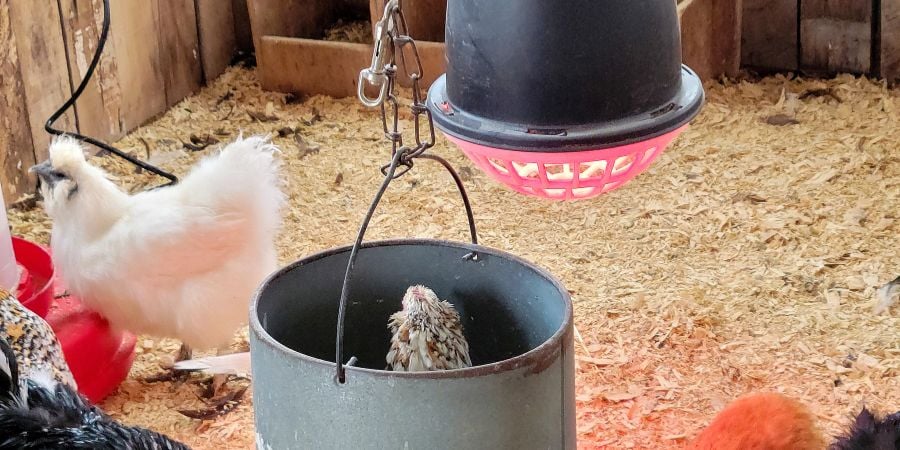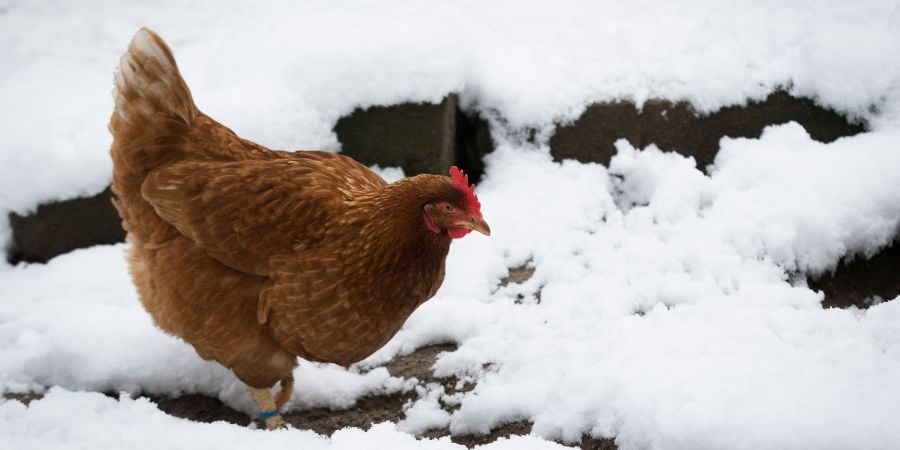Illuminating Comfort: How Heat Lamps Keep Your Chickens Cozy and Content
by Dakota Storage Buildings, on January 29, 2024

When raising backyard chickens during winter, it presents unique challenges. As temperatures plummet, ensuring the safety, warmth, and comfort of your chickens becomes essential. Chickens, like many animals, are susceptible to stress and health issues when faced with abrupt temperature changes, making their winter care critical for their well-being and productivity. The solution is multifaceted, involving not just a well-constructed coop, but also an understanding of the birds' natural behaviors and needs during the colder months. It is crucial to create an environment that not only shelters them from the harsh elements but also promotes their natural behaviors and overall well-being. In this blog, we delve into the nuances of keeping your chickens warm during the winter months. By the end of this guide, you will be equipped with the knowledge and confidence to keep your chickens cozy, content, and healthy, no matter how low the mercury drops.
Can Chickens Keep Themselves Warm?
One of the fascinating aspects of raising chickens is observing their innate ability to adapt to various weather conditions, including the biting cold of winter. Many new chicken owners are often surprised to learn just how resilient these birds are in the face of low temperatures. Chickens are equipped with a remarkable natural defense against cold: their feathers. These feathers are not just for show; they play a crucial role in thermal regulation. Each feather is capable of trapping air close to the chicken's body and providing insulation. During colder weather, chickens will puff up their feathers, increasing the insulating air space and keeping themselves warmer.
Chickens also have behavioral strategies to combat cold. On sunny winter days, they are often seen sunbathing, orienting their bodies to absorb maximum sunlight, which helps in raising their body temperature. At night, they huddle together, sharing body heat in a communal effort to stay warm. This behavior is particularly noticeable in colder temperatures, where communal warmth becomes essential for survival. Chickens have the ability to slightly adjust their metabolism in response to temperature changes. In colder weather, they can increase their metabolic rate, producing more body heat to keep warm. This is a subtle but effective adaptation that helps them maintain their body temperature even when the environment is unforgivingly cold.
However, these natural adaptations have their limits. While chickens can fluff their feathers and increase their metabolic heat production, these measures might not be enough during extreme cold spells, especially in northern climates where temperatures can drop well below what chickens can comfortably endure. Understanding the limitations of chickens' natural defenses against cold is crucial. While they are hardy animals, providing additional warmth through external sources becomes necessary in extreme conditions. This is where the role of a well-insulated coop, equipped with heat lamps and other warming measures, becomes vital. These supplemental heat sources can bridge the gap between the chickens' natural abilities and the demands of a harsh winter environment.
Preparing Your Chicken Coop for Winter

Ensuring your chickens are safe and warm during winter should be a top priority. The coop, a chicken’s primary habitat, plays a pivotal role in this. Preparing your coop for winter is not just about adding a heat source; it is about creating a comprehensive environment that supports your chickens' health and well-being during the colder months. The coop serves as the first line of defense against the harsh elements. In winter, the stakes are higher as the coop must also preserve warmth while avoiding moisture accumulation, which can lead to frostbite and respiratory issues in chickens. Here are several steps you can take to ensure your coop is ready for winter.
Provide Roosting Space
Roosts are more than just perches; they are vital for chickens to stay off the cold ground. Roosts should be wide enough for chickens to sit and cover their feet with their feathers, which is a natural way for them to keep their feet warm. Ensure there is enough space for all your chickens to roost comfortably without overcrowding, as this can lead to pecking and other stress-related behaviors.
Managing Drafts
Draft management is a delicate balance in winter coop preparation. Check for and seal any unintended gaps or cracks that might cause drafts at the level where your chickens roost. Use weather stripping or similar materials to seal these areas effectively.
Heat Sources and Safety
When considering heat sources, safety is paramount. Heat lamps can be a good option, but they must be installed correctly. Secure them well above the chickens' reach and away from any flammable materials. It is essential to use lamps specifically designed for use in livestock environments. Regular checks and maintenance of these heat sources are crucial to prevent any fire hazards.
Bedding and Manure Management
Manure management is a crucial aspect of maintaining a healthy and hygienic environment for raising chickens, especially during the winter months when they spend more time inside the coop. One effective strategy is the installation of trays beneath roosts and other perching areas. These trays serve as collection points for manure, significantly simplifying the cleaning process. Routinely remove manure and replace soiled bedding. Diligent upkeep not only ensures a clean living space for the chickens but also helps prevent the spread of diseases and maintains good air quality within the coop.
Protecting Your Chickens from Winter Illnesses
Maintaining the health and hygiene of your chickens during the cold months is as crucial as keeping them warm. Winter brings unique challenges in terms of disease management and overall flock health. The cold weather can exacerbate certain health issues in chickens. Respiratory diseases, in particular, can become more prevalent due to damp and cold conditions. Be watchful for symptoms like coughing, sneezing, nasal discharge, or labored breathing. These could indicate respiratory infections, which require prompt attention.
Frostbite is a real concern in extremely cold temperatures, particularly for breeds with large combs and wattles. It typically affects the extremities, such as the comb, wattles, and toes. Signs include discoloration (often blackened areas) and swelling. To prevent frostbite, ensure that the coop is well-ventilated to reduce moisture, and consider applying a protective balm to combs and wattles on particularly cold nights.
Maintain cleanliness in the coop to prevent the spread of disease. Regularly remove soiled bedding and replace it with fresh material. A clean, dry environment is essential to prevent the growth of harmful bacteria and fungi. Managing manure effectively, especially under roosting areas, is crucial. You will also want to conduct regular health checks on your chickens. Look for signs of illness, such as changes in eating or drinking habits, lethargy, abnormal droppings, or changes in egg production. Early detection of health issues is key to successful treatment.
Ensuring Chicken Health and Productivity During Winter
Raising chickens in winter may come with its challenges, but with the right knowledge and preparation, it is entirely manageable. While installing a heat source in the coop seems beneficial, it can be harmful. Heaters pose fire risks and can cause overheating or burns. With the right care, your flock will thrive in the cold season, staying happy and productive. A well-prepared coop, careful attention to health and hygiene, and a balanced approach to heating will ensure that your chickens not only survive the winter months but thrive in them. Remember, a happy, healthy flock is a productive flock, and your efforts during these colder months will pay off in the health and vitality of your chickens.

























